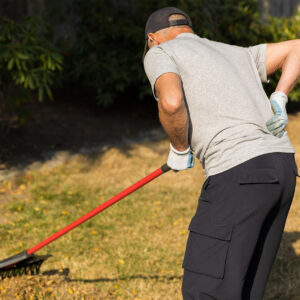How to Avoid Orthopedic Injuries While Gardening
Common Gardening Injuries and How to Avoid Them

Gardening is one of the most popular hobbies in the country and for good reason. It’s a great way to stay active, outdoors, and surrounded by the beauty of nature. But it’s tough work, and many overlook and underestimate the physical exertion needed to garden and landscape.
Fortunately, with some simple precautions, you can prevent gardening injuries and enjoy the fruits of your labor. Briana Ardolino, a licensed occupational therapist and certified hand therapist at Orlin & Cohen, explains common gardening injuries and tips to avoid them, including stretches and tools to make gardening easier on your joints.
Gardening and Yard Work Injuries Overview
A beautiful garden or yard is hard work, especially if you’re the one tending to it. The repetitive, demanding tasks of digging, bending, pruning, and kneeling can take their toll over time—causing strains and other overuse injuries.
Here are some of the most common gardening and yard work injuries our orthopedic specialists treat:
Lateral epicondylitis
Commonly known as tennis elbow, lateral epicondylitis is an overuse injury in the elbow caused by repetitive activities such as pruning or weeding.
de Quervain tenosynovitis
de Quervain tenosynovitis is a condition that causes pain and swelling at the base of the thumb due to repetitive gripping or pinching actions such as digging or pruning.
Carpal tunnel syndrome
Gardening requires repetitive hand motions to dig, plant, and prune. Over time, this stress can lead to carpal tunnel syndrome, where inflammation puts pressure on the wrist’s median nerve, resulting in pain, numbness, and tingling in the hands.
Neck pain
Improper posture while tending to plants or carrying heavy items, like bags of soil or mulch, can strain muscles in the neck and lead to pain.
Low back pain
Lifting heavy plants, tools, or bags of soil improperly can cause low back pain and strain. Bending and twisting while gardening can also contribute to this type of injury.
Pre-patellar bursitis
Gardener’s knee, or pre-patellar bursitis, is caused by excessive kneeling and causes inflammation of the bursa sac in front of the kneecap. This inflammation puts pressure on other parts of the knee, causing pain and visible swelling.
Tips to Avoid Gardening Injuries
Ready to enjoy more time in the garden with less pain? Use these tips to prevent gardening injuries.
Warm up with gardening stretches
Tight muscles are more prone to injury. Doing some simple stretches for a few minutes before and after will warm your muscles up, increasing mobility and blood flow, lowering your risk for injury, and improving recovery time. Gardeners can incorporate these stretches into their routine:
- Wrist stretch: Extend one arm in front of you with the palm facing down, then use the opposite hand to gently pull the fingers back towards the wrist. Hold for 10–15 seconds, then switch sides.
- Hamstring stretch: Sit on the ground with your legs extended in front of you, then reach forward toward your toes while keeping your back straight.
- Quad stretch: Stand with one hand resting on a wall or chair for balance, then bend the leg back and grasp your ankle with your other hand. Hold for 10–15 seconds, then switch sides.
- Shoulder stretch: Place one hand on your shoulder and bring your elbow across your chest, then use the opposite hand to gently pull the elbow closer to your chest. Hold for 10–15 seconds, then switch sides.
- Neck stretch: Slowly tilt your head to one side, bringing your ear towards your shoulder, and hold for 10–15 seconds. Repeat on the other side.
Pace yourself
Taking water breaks every 20 minutes helps your muscles recover and keeps you hydrated. It also encourages you to move your body, which can help you prevent overuse injuries and reduce excessive strain on any one body part.
Try rotating to a new task every 20 minutes. You can create a rotating circuit of weeding, digging, and lifting with water breaks in between. Set a timer on your phone or watch to remind yourself.
Proper lifting mechanics
When lifting heavy items, keeping a wide base of support and bending at the hips and knees while keeping your back straight is important. This can help prevent low back strain and knee injuries. Keeping the item as close to your body as possible will reduce neck, back, and knee strain.
When you’re ready to set the item down, don’t twist or bend your back. Instead, bend at the hip and knee, similar to how you picked it up, lowering the item to the ground to avoid back strain.
Effective and adaptive tools
Using sharp, clean tools improves the efficiency of your work and reduces strain on the body. You should also consider tools with large, ergonomic handles to relieve pressure on the finger joints. Long-handled tools can reduce back strain and are particularly helpful for taller gardeners. You can find many long-handled tools and attachments for weeding, digging, watering, and more.
Fitted gloves can also help you grip tools better, making them easier to use with less force needed. But make sure they fit correctly: Gloves that are too large do the opposite and can cause you to lose your grip, increasing the pressure you need to use, which can strain your hands, forearms, and elbows.
Alternative equipment
A wide range of tools and equipment can make gardening more comfortable, accessible, and enjoyable. Here are a few options and how they help ease stress on the body:
- Raised garden beds allow for a higher workspace, preventing the need to bend while gardening.
- Rolling planters offer similar benefits to raised garden beds since they require no bending to plant and make it easier to move flowers or vegetables with less effort.
- Worktables centralize everything you need—plants, tools, and accessories—in one location, which limits bending, lifting, and twisting and can help you save energy.
- Garden kneelers and knee cushions offer comfort while kneeling and prevent knee injuries and discomfort.
- Gardening stools can reduce the need for excessive bending and kneeling, and rolling garden scooters can be particularly beneficial for people at risk for falls since you don’t need to stand up and down—just roll to where you need to go.
When it comes to weeding out injuries in the garden, Orlin & Cohen knows that prevention is key. But some injuries are unavoidable. If you experience pain or discomfort while gardening, Orlin & Cohen’s top-ranked specialists are here for you.
With more Castle Connolly Top Doctors® than any other Long Island practice, our orthopedic doctors are among the best in the nation and can help you feel better, faster. Request an appointment.



